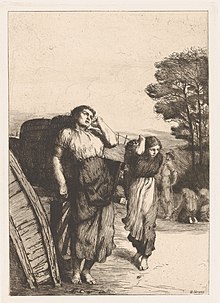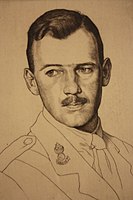William Strang
William Strang RA | |
|---|---|
 | |
| Born | 15 February 1859 |
| Died | 12 April 1921 (aged 62) |
| Education | Alphonse Legros |
| Alma mater | Slade School |
| Spouse | Agnes McSymon Rogerson |
| Children | Ian Strang, David Strang |
| Elected | Master of the Art Workers' Guild, President of the International Society of Sculptors, Painters and Gravers, Engraver Member of the Royal Academy. |
William Strang RA (13 February 1859 – 12 April 1921) was a Scottish painter and printmaker, notable for illustrating the works of Bunyan, Coleridge and Kipling.
Early life
Strang was born at Dumbarton, the son of Peter Strang, a builder, and was educated at the Dumbarton Academy. For fifteen months after leaving school he worked in the counting-house of a firm of shipbuilders, then in 1875, when he was sixteen, went to London. There he studied art under Alphonse Legros at the Slade School for six years.[1] Strang had great success as an etcher and became assistant master in the etching class. He was one of the founding members of the Royal Society of Painter-Etchers, and his work was part of its first exhibition in 1881. Some of his early plates were published in The Portfolio and other art magazines.
Work
He worked in many techniques: etching, drypoint, mezzotint, sand-ground mezzotint, burin engraving, lithography and woodcut. He cut a large wood engraving of a man ploughing, later published by the Art for Schools Association. A privately produced catalogue of his engraved work contained more than three hundred items. Amongst his earlier works were Tinkers, St. Jerome, A Woman Washing Her Feet, An Old Book-stall with a Man Lighting His Pipe from a Flare, and The Head of a Peasant Woman on sand-ground mezzotint. Later plates such as Hunger, The Bachelor's End and The Salvation Army were also important.
Some of his best etchings were done as series—one of the earliest, illustrating poet William Nicholson's Ballad of Aken Drum, is remarkable for clear, delicate workmanship in the shadow tones, showing great skill and power over his materials, and for strong drawing. Another praised series was The Pilgrim's Progress, revealing austere sympathy with John Bunyan's teaching. Samuel Taylor Coleridge's Ancient Mariner and Strang's own Allegory of Death and The Plowman's Wife, have served him with suitable imaginative subjects. Some of Rudyard Kipling's stories were also illustrated by him, and his likeness of Kipling was one of his most successful portrait plates. Other etched portraits included those of Ernest Sichel and of his friend Joseph Benwell Clark, with whom Strang collaborated in illustrating Lucian's True History (1894)[2] Baron Munchausen (1895) and Sinbad the Sailor and Ali Baba (1896).
Thomas Hardy, Sir Henry Newbolt, and other distinguished men also sat for Strang. Proofs from these plates have been much valued.
Painting
Strang produced many paintings,[3] portraits, nude figures in landscapes, and groups of peasant families, which were exhibited at the Royal Academy, The International Society, and several German exhibitions. He painted a decorative series of scenes from the story of Adam and Eve for the library of a Wolverhampton landowner named Hodson; they were exhibited at the Whitechapel exhibition in 1910. He made some drawings of the nude figure in silver point and red and black chalk.
He also painted landscapes, mostly small in size. In later years he developed a style of drawing in red and black chalk, with the whites and high lights rubbed out, on paper stained with water colour. His method gives qualities of delicate modelling and refined form and gradations akin to the drawings of Hans Holbein the Younger. He drew portraits in this manner of many members of the Order of Merit for the royal library at Windsor Castle. In 1902 Strang retired from the Royal Society of Painter-Etchers, as a protest against the inclusion in its exhibitions of etched or engraved reproductions of pictures. His work was subsequently seen principally in the exhibitions of the Royal Academy, the Society of Twelve and the International Society, to which he was elected in 1905. Strang was also elected an associate engraver of the Royal Academy when that degree was revived in 1906.[4] William Strang was master of the Art Workers Guild in 1907. His portrait can be seen at the Art Workers Guild 6 Queen Square London WC1N 3AT. He is buried at Kensal Green Cemetery, London.[5]
-
Lady with a Red Hat (Vita Sackville-West), 1918, Kelvingrove Museum and Art Gallery, Glasgow
-
The Temptation, 1899, Tate Gallery
Literary works
Strang also ventured into literature, creating "Death and the Ploughman's Wife", an illustrated ballad in 1888 (published 1894 by Lawrence and Bullen). He also wrote short stories, but these were not published.
Recognition
Strang was a member of the Art Workers' Guild, being elected as Master in 1907.[6][7] In 1918, he became President of the International Society of Sculptors, Painters and Gravers and in 1921 was elected an Engraver Member of the Royal Academy.[8]
Family
In 1885, William Strang married Agnes McSymon Rogerson (d. 1933), also from Dumbarton. They had four sons and one daughter. Their sons Ian Strang (1886–1952) and David Strang (1887–1967) were both artists.[9] William had at least one granddaughter, Joan Strang, born of David's short-lived marriage to the English soprano Dora Labbette.[10]
In 1955 David Strang gave impressions of the bulk of William Strang's etchings to the National Gallery of Scotland, many of which he had annotated for clarification of the subject matter.[11]
Etchings
-
The Cause of the Poor, 1890
-
Henry Austin Dobson, 1895
-
Rudyard Kipling, 1901
-
His son David Strang, c. 1915
-
The cover of Death and the Ploughman's Wife
-
Death the Judge, from the twelve-image portfolio The Doings of Death (1901)
-
Old Walls And Roman Viaduct, Segovia
References
- ^ Jones, Sarah Urwin (10 October 2014). "William Strang's rare talent is etched in history". Glasgow Herald. Retrieved 30 October 2014.
- ^ "Beardsley (Aubrey Vincent)" in T. Bose, Paul Tiessen, eds., Bookman's Catalogue Vol. 1 A-L: The Norman Colbeck Collection (UBC Press, 1987), p. 41
- ^ Goodchild, Anne. "William Strang 1859–1921". Tate Etc. Retrieved 30 October 2014.
- ^ Marsh, Jan. "William Strang (1859–1921), Painter and etcher". National Portrait Gallery. Retrieved 30 October 2014.
- ^ Paths of Glory. Friends of Kensal Green Cemetery. 1997. p. 95.
- ^ Past Master List (PDF). Art Workers' Guild.
- ^ Joseph Edwards, Frederick William Pethick-Lawrence Baron Pethick-Lawrence (1908). The Reformers' Year Book. p. 208.
- ^ "William Strang". National Galleries. Retrieved 20 October 2021.
- ^ Chilvers, Ian & John Glaves-Smith. (2009). A Dictionary of Modern and Contemporary Art. Oxford: Oxford University Press. p. 1644. ISBN 978-0-19-923965-8.
- ^ International, MusicWeb. "Charles A. Hooey – MusicWeb-International". musicweb-international.com.
- ^ National Gallery of Scotland: David Strang Gift, collection notes
- Attribution
This article incorporates text from a publication now in the public domain: Chisholm, Hugh, ed. (1911). "Strang, William". Encyclopædia Britannica. Vol. 25 (11th ed.). Cambridge University Press. p. 982.
External links
- 53 artworks by or after William Strang at the Art UK site
- Short biography of William Strang at 'Yellow Nineties Online'
- Sinbad the Sailor and Ali Baba and the Forty Thieves, illustrated by Strang and Joseph Benwell Clark, openly online in the University of Florida Digital Collections
- Laurence Binyon, William Strang: Catalogue of his etched work (1906) complete at wikimedia.org
- 1859 births
- 1921 deaths
- People from Dumbarton
- 19th-century engravers
- 20th-century engravers
- 19th-century Scottish painters
- Scottish male painters
- 20th-century Scottish painters
- Scottish printmakers
- Scottish engravers
- Scottish etchers
- Royal Academicians
- People educated at Dumbarton Academy
- Burials at Kensal Green Cemetery
- 20th-century British printmakers
- 19th-century British printmakers
- Masters of the Art Worker's Guild
- 19th-century Scottish male artists
- 20th-century Scottish male artists











